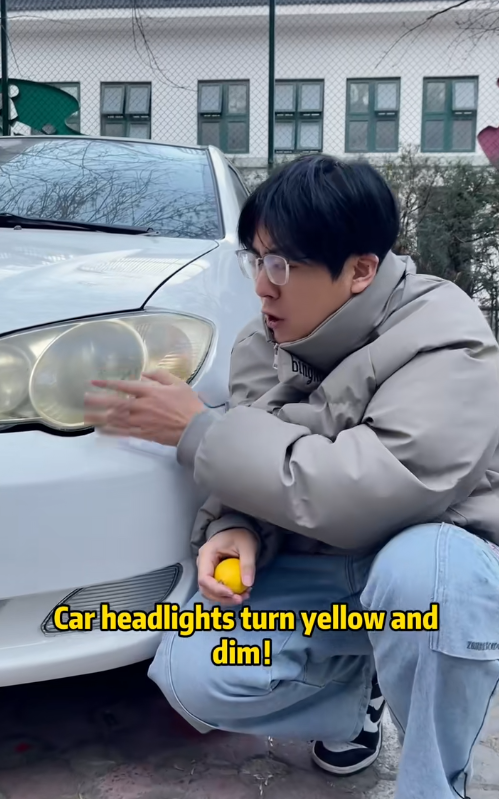
Headlights play a crucial role in vehicle safety, especially during night drives or bad weather. However, over time, your car’s headlights can become cloudy, yellowed, or foggy due to oxidation, UV exposure, dirt, and debris. Cloudy headlights reduce visibility, making night driving more dangerous. While there are many commercial headlight restoration kits available, a natural and affordable alternative is sitting in your kitchen—lemons. Yes, lemons! Their acidic properties make them excellent for cleaning and restoring clarity to your headlights. In this article, we’ll explore step-by-step how to use lemons to clean your car headlights and why it actually works.
Why Do Headlights Get Cloudy?
Before we dive into the cleaning process, it helps to understand why headlights become cloudy in the first place. Most modern headlights are made of polycarbonate plastic, which is durable but susceptible to oxidation. Over time, the protective coating on the plastic wears off, exposing the headlight to UV rays. This exposure causes the plastic to degrade, turn yellow, and become cloudy. Add in pollution, road grime, and moisture, and the result is a murky lens that significantly reduces your light output.
Why Lemons Work
Lemons are naturally acidic, containing about 5-6% citric acid. This acid can help break down oxidation and remove grime, restoring some clarity to plastic surfaces. When combined with a bit of abrasive material like baking soda or salt, lemon juice becomes even more effective at cleaning. This natural method is non-toxic, eco-friendly, and budget-friendly.

What You’ll Need
To clean your car headlights with lemons, gather the following items:
- 1 lemon (cut in half)
- Baking soda or table salt (optional but recommended)
- A clean microfiber cloth or rag
- Water
- Toothbrush or soft sponge (optional)
- Spray bottle with clean water
- Paper towels or another dry cloth
Step-by-Step Guide
Step 1: Wash the Headlights
Before applying lemon, wash the headlights with soap and water to remove surface dirt and dust. Use a soft cloth or sponge and rinse thoroughly with clean water. This step ensures that the lemon juice can work directly on the oxidized plastic instead of just surface grime.
Step 2: Cut the Lemon
Take a fresh lemon and cut it in half. One half should be enough for one headlight, depending on size and condition. If the lemon is dry, roll it on a counter with your palm to help release the juice.
Step 3: Add Baking Soda or Salt
Sprinkle baking soda or salt on the cut surface of the lemon. Baking soda acts as a mild abrasive to help scrub away the oxidized layer. Salt can also work, though it’s more coarse. The combination of the acid from the lemon and the abrasive from the soda or salt makes an effective cleaning paste.
Step 4: Scrub the Headlight
Rub the lemon (with baking soda or salt side) directly onto the headlight in circular motions. Apply gentle but consistent pressure. The lemon juice will start to react with the oxidation, and the abrasive will help lift it off. Continue rubbing for 3–5 minutes or until you see a difference in clarity.
If needed, use a toothbrush or soft sponge to reach into corners or crevices.
Step 5: Let It Sit
After scrubbing, let the lemon juice sit on the headlight for about 5–10 minutes. This gives the citric acid time to work on deeper layers of oxidation.
Step 6: Rinse and Wipe Clean
Using a spray bottle with clean water or a hose, rinse the headlight thoroughly to remove all lemon juice and debris. Wipe dry with a clean microfiber cloth or paper towel. You should notice an immediate improvement in clarity.

Repeat if Necessary
If your headlights were heavily oxidized, you may need to repeat the process a couple of times for best results. While lemons are effective, they’re not as powerful as commercial restoration kits or sanding methods, so be patient and persistent.
Optional: Apply a UV Sealant
Once your headlights are clean and clear, it’s a good idea to protect them to prevent future oxidation. You can buy a UV headlight sealant from an auto parts store or use a coat of car wax. Apply a thin layer with a microfiber cloth and buff it out according to the product’s instructions.
This step is especially important if you live in a sunny climate where UV exposure is high.
Benefits of Using Lemons for Headlight Cleaning
- Natural and Safe: No harsh chemicals, which means it’s safe for your hands, car paint, and the environment.
- Affordable: Lemons and baking soda are cheap and commonly found in most kitchens.
- Easy to Use: No need for complicated tools or equipment.
- Effective for Mild to Moderate Oxidation: While not a miracle cure, it’s surprisingly effective for routine cleaning and light restoration.
Limitations
- Not for Severe Damage: If your headlights are extremely oxidized or scratched, lemons may not be enough. You may need to use sandpaper, polishing compounds, or professional services.
- Temporary Fix: Without a UV sealant, oxidation can return in a few weeks or months.
- Time-Consuming for Larger Jobs: Cleaning with lemons is more hands-on and takes longer than using power tools or kits.

Tips for Best Results
- Use fresh lemons – Old or dry lemons won’t produce enough juice.
- Work in the shade – Direct sunlight can dry out the lemon juice too fast.
- Use gloves if needed – The acidity may irritate sensitive skin.
- Try combining with vinegar – If you don’t have lemons, white vinegar can be an alternative acid cleaner.
Conclusion
Cleaning your car headlights with lemons is an excellent DIY solution for anyone looking for a quick, natural, and budget-friendly method to restore clarity. While it might not be as powerful as a professional restoration, it’s surprisingly effective for light oxidation and regular maintenance. Best of all, it’s simple and safe—perfect for car owners who like to keep things clean using what they already have at home.
So the next time your headlights look foggy and dim, don’t rush to the auto store—head to your kitchen, grab a lemon, and give this easy trick a try!



